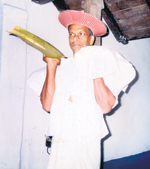|
|
||||
|
Rites and rituals of the Esala perahera
The Esala perahera season began with the Aluthnuwara Devale pageant, which was concluded on July 23. Thereafter in keeping with the Sinhala almanac at the nekath (auspicious time) of 5.45 a.m. on July 26, the Kap was planted (Kap situweema) at the Maha Vishnu Devale in Kandy. The four devalas in Kandy – Natha, Vishnu, Kataragama and Pattini planted the Kapa at this same auspicious time on the 26th. This marked the beginning of the Kandy Dalada Perahera. Vannaku Rala, a descendent from the family that has the rajakariya (official duty) to conduct the rituals at the Maha Vishnu Devale said that on July 25 he cut a branch from a jak tree, and prepared a Kapa to be brought from Aluthnuwara to the Maha Vishnu Devale in Kandy. It was placed at the Devale until the 26th morning, when it was his duty to place it in the Ehela Ge.
The Kapa is cut from a tree such as Rukattana or Jak, which has a milky sap, he explains. The tree should not have borne any fruit before, and should be about one-and-a-half feet in height. It was wrapped in a white cloth and placed in the Maha Vishnu Devale until the morning of July 26 when it was ceremonially placed in the Ehela Ge, which is situated within the premises of the Devale. At the same time the Chief Kapurala of the devale brought the Vishnu deity’s abarana (insignia) and a small procession with two flag bearers of the Hathara Korale and the Buddhist flag, two drummers playing the thammettama and the daula, and another blowing the horanewa paraded round the devale. This was conducted for five days within the premises of the devale until July 30. There are five families at Aluthnuwara who do this rajakariya during the Esala perahera season on the Thattu maruwa basis (taking turns), says Vannaku Rala. Each family has a different duty to perform. Vannaku Rala’s family received a paddy field for performing these duties. On the night of July 31, the first Kumbal Perahera (procession) circled the temple square. On this day people take their young children to view the procession believing that it brings them good luck. After completing five days of the Kumbal perahera on August 5, the Randoli Perahera parades along a longer route. The last day of the Randoli Perahera, which will be August 9, is considered the most spectacular. Early in the morning on August 10, the four Devale peraheras will proceed to Getembe for the Diya Kepeema (water cutting ceremony), and return to their respective devales. The Kap which was planted in the devales will be taken and thrown into the Mahaweli river at the time of the water cutting ceremony. Again at the auspicious time of 12.25 in the afternoon on the same day, the four devalas will assemble near the Pillaiyar Kovil at Katukele, and join the Sri Dalada Maligawa perahera to parade the streets, and this will end this year’s Esala Perahera. |
||||
Copyright © 2006 Wijeya Newspapers
Ltd. All rights reserved. |
